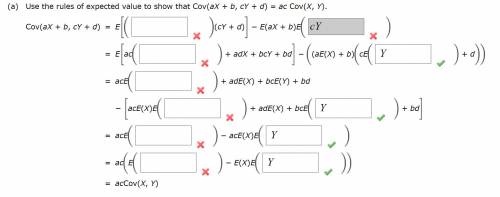(a)
Use the rules of expected value to show that
Cov(aX + b, cY + d) = ac Cov(X, Y).
...

Mathematics, 25.10.2021 09:10, yoyoyo42
(a)
Use the rules of expected value to show that
Cov(aX + b, cY + d) = ac Cov(X, Y).
(b)
Use part (a) along with the rules of variance and standard deviation to show that
Corr(aX + b, cY + d) = Corr(X, Y)
when a and c have the same sign.
(c)
What happens if a and c have opposite signs?




Answers: 1
Other questions on the subject: Mathematics

Mathematics, 21.06.2019 20:00, kennrecklezz
Which of these tools or constructions is used to inscribe a hexagon inside a circle?
Answers: 1

Mathematics, 22.06.2019 00:30, victoria8281
Which ordered pair identifies a point in quadrant iv? a) (2, 5) b) (0, 1) c) (-1, -1) d) (12, -5) which quadrant is (-4,-6) in? a) i. b) ii. c) iii. d) iv.
Answers: 3

Mathematics, 22.06.2019 02:30, aidenmanpig
Match each set of points with the quadratic function whose graph passes through those points
Answers: 1

Mathematics, 22.06.2019 02:30, Leii691
According to a research study, parents with young children slept 6.4 hours each night last year, on average. a random sample of 18 parents with young children was surveyed and the mean amount of time per night each parent slept was 6.8. this data has a sample standard deviation of 0.9. (assume that the scores are normally distributed.) researchers conduct a one-mean hypothesis at the 5% significance level, to test if the mean amount of time parents with young children sleep per night is greater than the mean amount of time last year. the null and alternative hypotheses are h0: μ=6.4 and ha: μ> 6.4, which is a right-tailed test. the test statistic is determined to be t0=1.89 using the partial t-table below, determine the critical value(s). if there is only one critical value, leave the second answer box blank.
Answers: 3
Do you know the correct answer?
Questions in other subjects:





Mathematics, 13.10.2019 18:00

Social Studies, 13.10.2019 18:00

Mathematics, 13.10.2019 18:00

Biology, 13.10.2019 18:00







